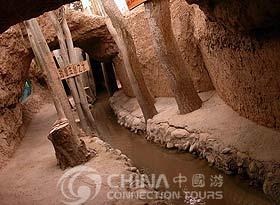 Karez Well is a kind of underground water works invented and built by laboring people of various ethnic groups in our country to adapt to the natural environment in dry region. The history of the karez, mainly used in the Hami and Turpan areas in Xinjiang, where it is hot and dry, dates back to the Han Dynasty (206 B.C. - 220 A.D.). It is considered one of the three great projects in ancient China, along with the Great Wall and the Beijing-Hangzhou Grand Canal. Why Karez Wells were built in great number in Turpan Basin can be attributed to the local natural geographical conditions. To the north of Turpan Basin is Bogda Mountain and to its west Kalawucheng Mountain. In summer, large amounts of snow broth and rainwater flow into Turpan Basin and infiltrate into the ground, thus making an adequate water source under ground for Karez Wells. Earth in Turpan Basin is solid and good for building well and underground channel. In Turpan it is very dry and hot in summer, and land here has a high evaporation rate. In wind season, the strong wind here can blow sands into every corner here. After wind, a lot of farmland and water channels are buried by sands. But Karez Wells can supply waters through underground channels and is independent of the effect of season and wind and sand. In addition, Karez Wells have a very low evaporation rate and a stable supply of water, and can irrigate farmland all the year round. The word Karez means well.
Karez Well is a kind of underground water works invented and built by laboring people of various ethnic groups in our country to adapt to the natural environment in dry region. The history of the karez, mainly used in the Hami and Turpan areas in Xinjiang, where it is hot and dry, dates back to the Han Dynasty (206 B.C. - 220 A.D.). It is considered one of the three great projects in ancient China, along with the Great Wall and the Beijing-Hangzhou Grand Canal. Why Karez Wells were built in great number in Turpan Basin can be attributed to the local natural geographical conditions. To the north of Turpan Basin is Bogda Mountain and to its west Kalawucheng Mountain. In summer, large amounts of snow broth and rainwater flow into Turpan Basin and infiltrate into the ground, thus making an adequate water source under ground for Karez Wells. Earth in Turpan Basin is solid and good for building well and underground channel. In Turpan it is very dry and hot in summer, and land here has a high evaporation rate. In wind season, the strong wind here can blow sands into every corner here. After wind, a lot of farmland and water channels are buried by sands. But Karez Wells can supply waters through underground channels and is independent of the effect of season and wind and sand. In addition, Karez Wells have a very low evaporation rate and a stable supply of water, and can irrigate farmland all the year round. The word Karez means well.
As an irrigation system using underground water, the karez consists of four parts: a hole as deep as 50 to 60 meters, an underground canal, a above-ground canal and a small reservoir. It is built this way: first, to find water source in a place where there is underground water current, second, dig out vertical wells with certain distance in between, then, to build underground channel connecting these wells and thus water will flow through the underground channel.
The outlet of underground channel is connected to the aboveground channel and thus underground water can flow out and irrigate farmland through the aboveground channel. Wandering underground over 5,000 kilometers, the karez has also be called "the underground Great Wall."
